辜鸿铭的翻译思想初探_朱宝锋
- 格式:pdf
- 大小:907.31 KB
- 文档页数:4
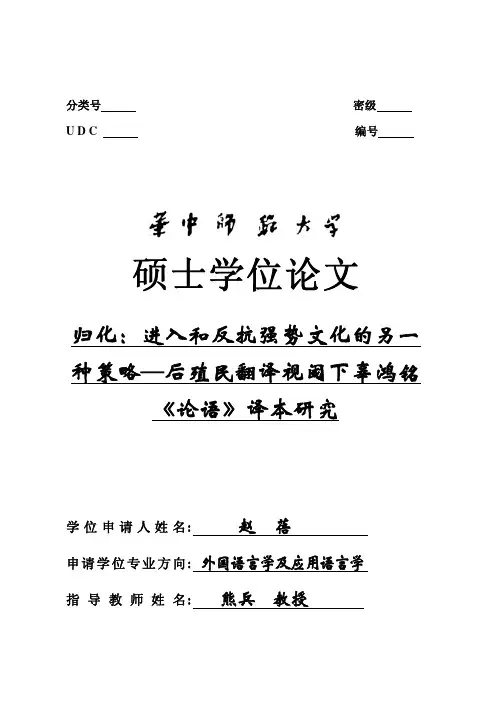
分类号密级U D C 编号硕士学位论文归化:进入和反抗强势文化的另一种策略—后殖民翻译视阈下辜鸿铭《论语》译本研究学位申请人姓名:赵 蓓申请学位专业方向: 外国语言学及应用语言学指导教师姓名:熊兵 教授Domestication:Another Tactic to Enter and Challenge the Hegemonic Culture —A Case Study of Ku Hungming'sTranslation of Lun Y u from Postcolonial TranslationPerspectiveA ThesisSubmitted in Partial Fulfillment of the Requirements for the M.A.Degree in Foreign Linguistics and Applied Linguistics(On Translation Theory and Practice)ByZhao BeiPostgraduate ProgramSchool of Foreign LanguagesHua Zhong UniversitySupervisor:Xiong BingAcademic Title:Associate Professor Signature:ApprovedApril,2009华中师范大学学位论文原创性声明和使用授权说明原创性声明本人郑重声明:所呈交的学位论文,是本人在导师指导下,独立进行研究工作所取得的研究成果。
除文中已经标明引用的内容外,本论文不包含任何其他个人或集体已经发表或撰写过的研究成果。
对本文的研究做出贡献的个人和集体,均已在文中以明确方式标明。
本声明的法律结果由本人承担。
作者签名:日期:年月日学位论文版权使用授权书本学位论文作者完全了解学校有关保留、使用学位论文的规定,即:学校有权保留并向国家有关部门或机构送交论文的复印件和电子版,允许论文被查阅和借阅。
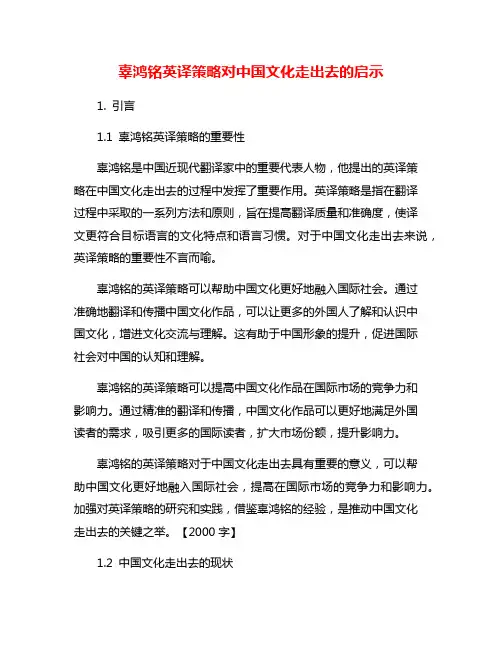
辜鸿铭英译策略对中国文化走出去的启示1. 引言1.1 辜鸿铭英译策略的重要性辜鸿铭是中国近现代翻译家中的重要代表人物,他提出的英译策略在中国文化走出去的过程中发挥了重要作用。
英译策略是指在翻译过程中采取的一系列方法和原则,旨在提高翻译质量和准确度,使译文更符合目标语言的文化特点和语言习惯。
对于中国文化走出去来说,英译策略的重要性不言而喻。
辜鸿铭的英译策略可以帮助中国文化更好地融入国际社会。
通过准确地翻译和传播中国文化作品,可以让更多的外国人了解和认识中国文化,增进文化交流与理解。
这有助于中国形象的提升,促进国际社会对中国的认知和理解。
辜鸿铭的英译策略可以提高中国文化作品在国际市场的竞争力和影响力。
通过精准的翻译和传播,中国文化作品可以更好地满足外国读者的需求,吸引更多的国际读者,扩大市场份额,提升影响力。
辜鸿铭的英译策略对于中国文化走出去具有重要的意义,可以帮助中国文化更好地融入国际社会,提高在国际市场的竞争力和影响力。
加强对英译策略的研究和实践,借鉴辜鸿铭的经验,是推动中国文化走出去的关键之举。
【2000字】1.2 中国文化走出去的现状随着中国经济的快速发展和中国在国际舞台上的日益崛起,中国文化走出去的步伐也在不断加快。
越来越多的中国电影、音乐、文学作品被引进到国际市场,吸引了越来越多的海外观众。
中国传统文化的魅力和独特性也吸引着外国人的目光,成为他们研究和学习的对象。
在中国文化走出去的过程中还存在一些问题和挑战。
由于语言和文化的差异,很多中国作品在海外市场上并不为人所了解,无法得到应有的关注和认可。
一些中国作品在海外的宣传和推广方面做得不够好,导致其影响力和知名度不高。
还有一些中国文化产品在国际市场上面临着激烈的竞争,需要不断提升自身的质量和创新能力。
面对这些挑战,我们需要加强对中国文化走出去的策略研究和实践,找到适合中国文化特点和国际市场需求的推广方式和策略。
借鉴辜鸿铭的英译策略,可以为中国文化走出去提供一些建设性的启示和指导,帮助我们更好地提升中国文化在国际上的传播和影响力。
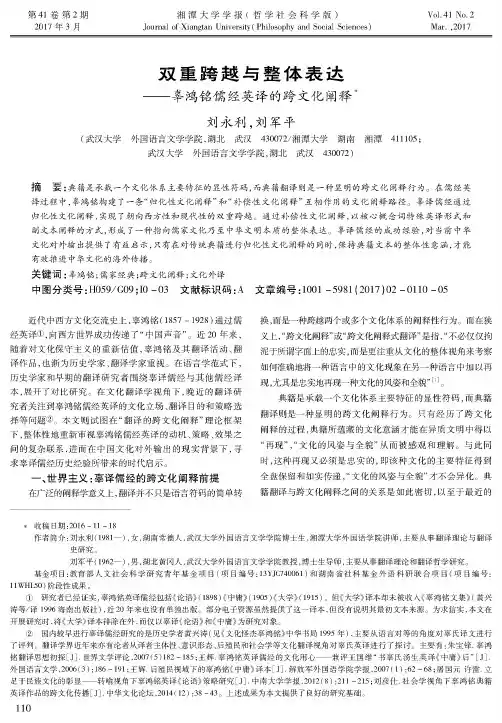
第41卷第2期2017年3月湘潭大学学报(哲学社会科学版)Journal of Xiangtan University(Philosophy and Social Sciences)Vol.41 No.2Mar. ,2017双重跨越与整体表达—辜鸿铭儒经英译的跨文化阐释*刘永利,刘军平(武汉大学外国语言文学学院,湖北武汉430072/湘潭大学湖南湘潭411105;武汉大学外国语言文学学院,湖北武汉430072)摘I要:典籍是承载一个文化体系主要特征的显性符码,而典籍翻译则是一种显明的跨文化阐释行为。
在儒经英译过程中,辜鸿铭构建了一条“归化性文化阐释”和“孙偿性文化阐释”互相作用的文化阐释路径。
辜译儒经通过归化性文化阐释,实现了朝向西方性和现代性的双重跨越。
通过孙偿性文化阐释,以核心概念词特殊英译形式和副文本阐释的方式,形成了一种指向儒家文化乃至中华文明本质的整体表达。
辜译儒经的成功经验,对当前中华文化对外输出提供了有益启示,只有在对传统典籍进行归化性文化阐释的同时,保持典籍文本的整体性意涵,才能有效推进中华文化的海外传播。
关键词:辜鸿铭;儒家经典;跨文化阐释;文化外译中图分类号:H059/G09; 10-03 文献标识码:A 文章编号= 1001 -5981 (2017) 02 -0110 -05近代中西方文化交流史上,辜鸿铭(1857 - 1928)通过儒经英译①,向西方世界成功传递了 “中国声音”。
近20年来,随着对文化保守主义的重新估值,辜鸿铭及其翻译活动、翻译作品,也渐为历史学家、翻译学家重视。
在语言学范式下,历史学家和早期的翻译研究者围绕辜译儒经与其他儒经译本,展开了对比研究。
在文化翻译学视角下,晚近的翻译研究者关注到辜鸿铭儒经英译的文化立场、翻译目的和策略选择等问题©。
本文则试图在“翻译的跨文化阐释”理论框架下,整体性地重新审视辜鸿铭儒经英译的动机、策略、效果之间的复杂联系,进而在中国文化对外输出的现实背景下,寻求辜译儒经历史经验所带来的时代启示。
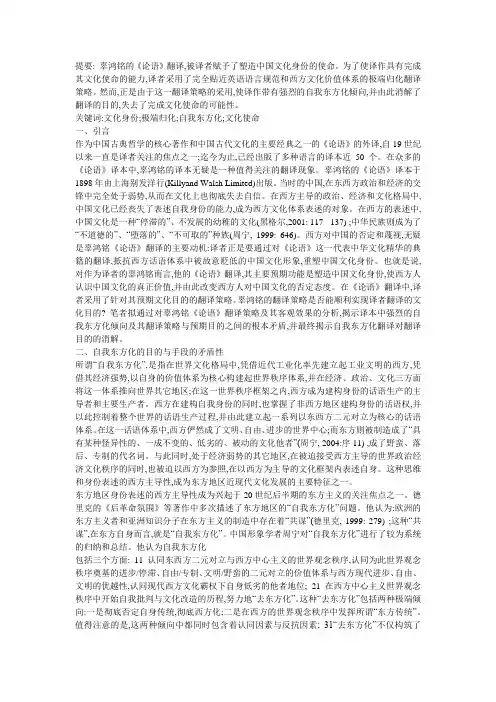
提要: 辜鸿铭的《论语》翻译,被译者赋予了塑造中国文化身份的使命。
为了使译作具有完成其文化使命的能力,译者采用了完全贴近英语语言规范和西方文化价值体系的极端归化翻译策略。
然而,正是由于这一翻译策略的采用,使译作带有强烈的自我东方化倾向,并由此消解了翻译的目的,失去了完成文化使命的可能性。
关键词:文化身份;极端归化;自我东方化;文化使命一、引言作为中国古典哲学的核心著作和中国古代文化的主要经典之一的《论语》的外译,自19世纪以来一直是译者关注的焦点之一;迄今为止,已经出版了多种语言的译本近50个。
在众多的《论语》译本中,辜鸿铭的译本无疑是一种值得关注的翻译现象。
辜鸿铭的《论语》译本于1898年由上海别发洋行(Killyand Walsh Limited)出版。
当时的中国,在东西方政治和经济的交锋中完全处于弱势,从而在文化上也彻底失去自信。
在西方主导的政治、经济和文化格局中,中国文化已经丧失了表述自我身份的能力,成为西方文化体系表述的对象。
在西方的表述中,中国文化是一种“停滞的”、不发展的幼稚的文化(黑格尔,2001: 117 - 137) ;中华民族则成为了“不道德的”、“堕落的”、“不可取的”种族(周宁, 1999: 646)。
西方对中国的否定和蔑视,无疑是辜鸿铭《论语》翻译的主要动机:译者正是要通过对《论语》这一代表中华文化精华的典籍的翻译,抵抗西方话语体系中被故意贬低的中国文化形象,重塑中国文化身份。
也就是说,对作为译者的辜鸿铭而言,他的《论语》翻译,其主要预期功能是塑造中国文化身份,使西方人认识中国文化的真正价值,并由此改变西方人对中国文化的否定态度。
在《论语》翻译中,译者采用了针对其预期文化目的的翻译策略。
辜鸿铭的翻译策略是否能顺利实现译者翻译的文化目的? 笔者拟通过对辜鸿铭《论语》翻译策略及其客观效果的分析,揭示译本中强烈的自我东方化倾向及其翻译策略与预期目的之间的根本矛盾,并最终揭示自我东方化翻译对翻译目的的消解。

生态翻译视角下的辜鸿铭《论语》英译研究I believe that smartand intellectual western readers and scholars can think about Chinese and Chinese cultur e from a brand-new perspective, get rid of prejudice and have a more positive attitude towards and Chinese tradition al culture and China.” That means Ku Hungming hopes to change the western attitude towards China and give up t he the violence of imperialist.Translation purpose is of vital importance in the process of a text, and we can know Ku’s English version tra nslation of Lun Yu is fit for temporal social background and has a great influence on Chinese and westerners.3.Embodiment of the Principles of Eco-translatology Adaptation in Ku Hungming's English Translation of Lun Y u3.1 Adaptation of the Translational Eco-environmentLefevere once said:” translators function plays an important role in a given culture at a given time.” At the be ginning, we have introduced the history and times background-eco-environment where Ku Hungming lives, because s ome special times and history bac kground will greatly influence translators’ thinking and behaviors. Eco-environment i s closely connected with the following factors, including society, politics, culture and communication.3.1.1 Society and PoliticsBefore 1840, China is an independent country, and westerners regard China as a mysterious, old and magica l country with all kind of goods everywhere and endless natural resources. In fact, because of the complement of cl ose-door policy for a long time, it seriously hinders the development and enhancement of Chinese society. However, western countries, such as England, France and others have began industrial revolution, and the production takes p lace of hand labor, creating plenty of wealth and excellent science technology, which produces huge energy more th an previous sum of all times. However, the quick development of western countries also deepens capital contraction, and they need to conquer more countries to enlarge their power, and China is one of their destinations. Although Qing Dynasty has rich resources, yet the close-door policy makes him behind the world trend. Western countries sta rt their attacks to China, and China can’t withstand the force of imperialism, and they have to sign the first unequal treaty-Nanjing Treaty, which marks the beginning of semi-colonial and semi -feudal society. After Nanjing Treaty, a series of unequal treaties are signed. Therefore, some intellectuals begin start their journey of saving China, calming “Chinese learning as the fundamental structure and western learning for practical use”. This is the special stage in C hina’s history Ku Hungming experiences.3.1.2 CultureCulture is closely connected with politics, and politics influences various aspects of culture. In the late ninetee nth century and early twentieth century, faced with the aggressions of western countries, some Chinese begin to thin k of Chinese culture. Different people have different ideas. Some advocate we should learn from western countries, and others have a opposite suggestion, and the culture collision appears little by little. Especially after the war betwe en China and Japan in1894, some people like Liang Qichao, Kang Youwei and others advocate constitutional monar chy system and capitalism. But their measures and actions end up with failure. The theme “Chinese learning as the fundamental structure and western learning for practical use” means Chinese traditional culture is the base and west ern culture and technology is the supplement, and both of them contribute to the development of China society.Ku Hungming believes imitating completely western countries cannot help Qing Dynasty get rid of the present situation, and meanwhile, foreigners can’t look up to Chinese forever if we don’t change the current situation. The o nly way for us to let westerners show respect to Chinese people and Chinese nation is to make them understand C hinese culture-a nation with its own thinking and civilization. Therefore, it is urgent for Chinese to spread Chinese cu lture and show the colorful Chinese civilization. It is a must for Ku Hungmign to translate Lun Yu with such times a nd history background.3.1.3 CommunicationBecause of a series of unequal treaties, China becomes the aggression target by more and more countries, p lunging into semi-colonial and semi-feudal society. Therefore, intercultural communication is not equal, and westerners look down upon Chinese nation and Chinese culture, only regarding western world as the center of the earth. Altho ugh China does not fully fall into colony, western colonizers show their contempt from the bottom of their heart. For example, Samoar once writes the following words in his book Understanding Intercultural Communication: stereotypes also keep us from being successful as communicators, because they are oversimplified, overgeneralized and exaggerated. From that, we can see Chinese nation and Chinese civilization is belittled by those who don’t have any conce pt in their minds about China. In order to eradicate the prejudice and communicate equally between China and west ern countries, Ku Hungming decides to introduce Chinese classical culture to the western world, and Lun Yu, which is filled with Chinese culture spirit, is his best choice.Thus, all factors including society, politics, culture and communication contribute t o the Lun Yu’s translation. E co-environment plays an important role in the process of Lun Yu’s translation.3.2 Translator's AdaptationKu Hungming’s success in the translation of Lun Yu is closely connected with his own experiences.3.2.1 Ku Hungming’s Ab ility in English and ChineseKu Hungming is born in Malaysia where many oversea Chinese who have deep patriotic feelings live there in 1857, and his hometown is in Fujian Province where his grandfather and father once live, and they serve for the g overnment of English colonists. His mother can speak English and Portuguese. When he is ten, he moves to Englan d with his adoptive father, and he studies in England for a long time and is admitted into University of Edinburgh, m ajoring in literatures, including Pa radise Lost, Faust, Shakespeare’s plays and others. His teacher is Scotland famous essayist and historian, Carlyle, and under the guidance of his teacher, Ku completes his postgraduate courses succ essfully, and at that time he is only twenty years old. To our surprise, he masters more than ten kinds of languages, including English, Spanish, French, and Greek and so on.His fluent English can’t be separated with his western education experience. Lin Yutang once said:” no one in China has the ability to overp ass Ku’s English level.” His English is full of elegance, wit and fluency. Ku doesn’t st udy Chinese systematically until 1882 when he meets an official of Qing Government called Ma Jianzhong. Form Ma, Ku Hungming really experiences the thinking and essence of Chinese classical culture falls in love with Chinese cla ssical culture. In 1883, he comes back to China for the first time, feeling the beauty of motherland’s rivers and mou ntains, but he also has a complex emotion to the temporal situation of China. Before long, Ku goes to Hongkong to study Chinese, especially digging into Chinese classical literatures. His talent in languages is found by Zhang Zhidong who masters Sinology, and Ku studies them harder and harder, memorizing lots of Chinese classical literature, w hich lays a solid basis to the subsequent Lun Yu’s translation.Since then, the background of knowing Chinese and English makes Ku Hungming completely adapt to the rol e of translating Chinese classical literatures. Good knowledge of languages helps Ku to successfully translate Lun Y u.3.2.2 Ku Hungming’s Cultural OrientationIn addition to translators’ adaptation in Chinese and English, cultural orientation of translators also plays an im portant role in the process of Ku Hungming’s translation. At the very beginning, Ku has a strong Patriotic feeling an d national consciousness. When he studies in the western country, romanticism has a great influence on Ku Hungmi ng. At the same time, his teacher upholds monarch, which is similar to Chinese traditional moral and ethic advocatin g monarch’s paramountcy. Many famous people refer to Chinese civilization in their works, for example, Emerson thi nks Confucius is the honor of China and the soul of Chinese traditional culture. They also think highly of Ku Hungm ing, and duo to their influence, Ku Hungming clearly comprehends the concept and relation between Confucianism a nd romanticism, therefore, he has his own thinking and ideology with unique emotion of Chinese culture and the ide a of romanticism.Ku Hungmin g believes that Chinese Confucian culture is attractive, and it can change western people’s attitud e towards China and embodies the essence of Chinese nation. Therefore, he gets down to translating Lun Yu into English so as to better spread Chinese image and culture.3.3 Multidimensional Adaptation and Selection in the Translation of Lun YuAccording to the theory of Eco-translatology, the translator will make the choice of adaptive translation strategi es on the basis of adaptation to the ecological environment of translation. This adaptive selection covers multiple di mensions, mainly embodied in the following areas3.3.1 Linguistic dimensionChinese belonging to Sino-Tibetan system has a very loose structure while English belnging to Indo European system has a compact structure. At the same time, because Chinese is evolved from pictograms, the character is full of Imagery. Therefore, when Chinese is translated into English, it requires the translator to complete presentation of original language. Ku Hungming’s translation of Lun Yu embodies linguistic dimension.Example: 《论语·学而》:子曰:“巧言令色,鲜矣仁!”Ku Hungming translated it into “ With plausible speech and fine manners will seldom be found moral characte r.”In exclamatory sentences of ancient Chinese, the inversion is often used in order to emphasize the predicate whic h is often advanced. In the text, “鲜矣仁” is an inversion structure, and the normal syntactic order is “仁鲜矣”. “矣”is equivalent to the modern Chinese “啊”, and the exclamation point is added to the end of the sentence to the stress tone of speakers, which has a strong imagery when it is connected with the text. In the transaltion of Ku Hun gming, it begins with the word "with", then uses the passive voice "will be found" to gradually strengthen the tone. A lthough the end of the translation does not use exclamation point, the tone approaches original text without showing weakness. It can be seen that the choice of the language and the structure of target language of the translator dep ends on the understanding of the original text to some extent.The reason why Ku Hungming can translate Lun Yu so perfect is his profound Chinese knowledge. From the perspective of Eco-translatology, Ku Hungming can better deal with the language positioning.3.3.2 Cultural DimensionThe adaptation and selection of cultural dimension is that the translator pays attention to the transmission and interpretation of bilingual culture in the process of translation. This translation requires translators to understand the similarities and differences between the source language culture and the target language culture in essence, adapt to the cultural environment of the source language, and avoid the distortion of the source language culture. Ku Hungm ing attaches great importance to the transmission of cultural connotation in the process of translation. Under the bac kground of that ecological environment of Ku’s time, he is eager that the Chinese culture can be recognized by the western world so that we can reestablish the image of the Chinese people. Therefore, Ku Hungming often uses the words of western literary giants such as Wordsworth, Emerson and others to interpret the Confucian thought in the n otes and utilizes the similarities between the Chinese and Western cultures to establish the bridge of communication.Example: “虽疏食菜羹,必祭,必齐如也。
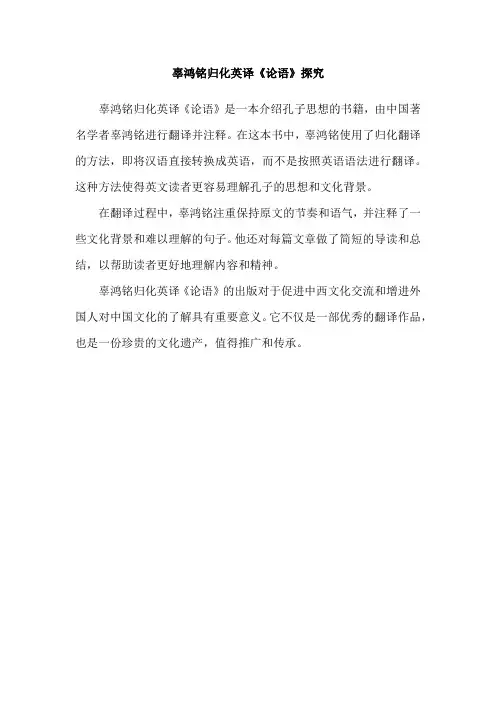
辜鸿铭归化英译《论语》探究
辜鸿铭归化英译《论语》是一本介绍孔子思想的书籍,由中国著名学者辜鸿铭进行翻译并注释。
在这本书中,辜鸿铭使用了归化翻译的方法,即将汉语直接转换成英语,而不是按照英语语法进行翻译。
这种方法使得英文读者更容易理解孔子的思想和文化背景。
在翻译过程中,辜鸿铭注重保持原文的节奏和语气,并注释了一些文化背景和难以理解的句子。
他还对每篇文章做了简短的导读和总结,以帮助读者更好地理解内容和精神。
辜鸿铭归化英译《论语》的出版对于促进中西文化交流和增进外国人对中国文化的了解具有重要意义。
它不仅是一部优秀的翻译作品,也是一份珍贵的文化遗产,值得推广和传承。
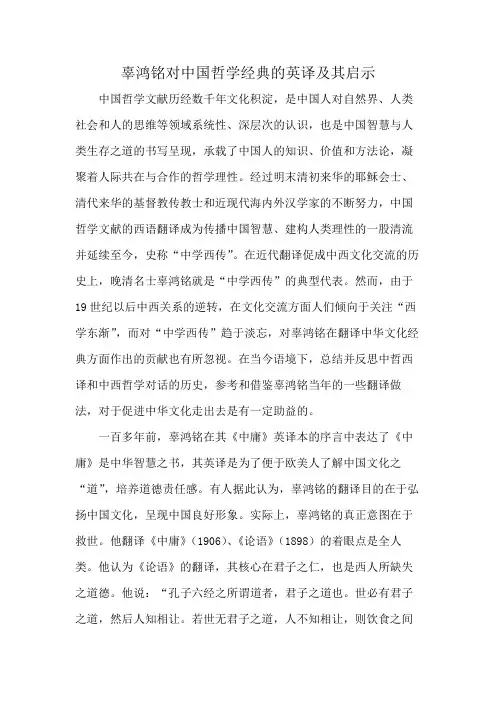
辜鸿铭对中国哲学经典的英译及其启示中国哲学文献历经数千年文化积淀,是中国人对自然界、人类社会和人的思维等领域系统性、深层次的认识,也是中国智慧与人类生存之道的书写呈现,承载了中国人的知识、价值和方法论,凝聚着人际共在与合作的哲学理性。
经过明末清初来华的耶稣会士、清代来华的基督教传教士和近现代海内外汉学家的不断努力,中国哲学文献的西语翻译成为传播中国智慧、建构人类理性的一股清流并延续至今,史称“中学西传”。
在近代翻译促成中西文化交流的历史上,晚清名士辜鸿铭就是“中学西传”的典型代表。
然而,由于19世纪以后中西关系的逆转,在文化交流方面人们倾向于关注“西学东渐”,而对“中学西传”趋于淡忘,对辜鸿铭在翻译中华文化经典方面作出的贡献也有所忽视。
在当今语境下,总结并反思中哲西译和中西哲学对话的历史,参考和借鉴辜鸿铭当年的一些翻译做法,对于促进中华文化走出去是有一定助益的。
一百多年前,辜鸿铭在其《中庸》英译本的序言中表达了《中庸》是中华智慧之书,其英译是为了便于欧美人了解中国文化之“道”,培养道德责任感。
有人据此认为,辜鸿铭的翻译目的在于弘扬中国文化,呈现中国良好形象。
实际上,辜鸿铭的真正意图在于救世。
他翻译《中庸》(1906)、《论语》(1898)的着眼点是全人类。
他认为《论语》的翻译,其核心在君子之仁,也是西人所缺失之道德。
他说:“孔子六经之所谓道者,君子之道也。
世必有君子之道,然后人知相让。
若世无君子之道,人不知相让,则饮食之间狱讼兴焉,樽俎之地矛戈生焉。
余谓教之有无,关乎人类之存灭盖于此也。
”显然,辜鸿铭翻译中国经典的关注点在于全人类的文明教化。
之所以推崇中国文化,是因为他试图依据儒家文化设计一种理想的道德人格,并将其推广到全世界,重建人类道德伦理秩序。
辜鸿铭在翻译中国哲学经典时,力图将其中包含的道德价值译介到西方文化之中,以力劝西方社会接受仁爱道德文明,放弃枪炮暴力文明。
虽然“四书五经”之前已有翻译,但辜鸿铭认为西方传教士的翻译并不准确,甚至有误读之嫌。

从读者接受理论视角论辜鸿铭的英译本《论语》、《中庸》【摘要】译者对读者理解接受的观照关系到不同语言文化之间的交流能否顺畅地进行,中西翻译史上有不少翻译家和翻译理论家都强调了关注译文读者的重要性。
本文以辜鸿铭的英译本《论语》、《中庸》为例,从20世纪中期兴起的读者接受理论的视角来探讨他的翻译策略和方法。
【关键词】读者接受理论译者辜鸿铭期待视野策略和方法读者接受理论读者接受理论源于20世纪50年代的一种文学批评理论,主要阐述作者、作品和读者之间的关系,强调读者对作品接受理解的意义,把创作过程和鉴赏过程有机结合,形成一个相互联系,互为条件、彼此影响推进的完整的文学过程。
它以姚斯(h.r.jauss)、英伽登(r.in garden)和伊瑟尔(w.iser)等理论家为代表,要求改变过去文学理论中的“作者中心论”,确立“读者中心论”,认为文本因读者的阅读而产生不同意义,而这些有个性的接受应受到重视。
姚斯注重读者的接受对文本意义生成和文学史的研究方法的启示。
他在《文学史作为向文学理论的挑战》一文中借用并提出以“期待视野”(horizon of expectations)为基础的文学接受理论,系统阐释了读者的期待视野对文学接受的重大意义。
期待视野指读者在阅读理解之前对作品的定向期待,这种期待有一个由以往的阅读经验和记忆所决定的视野。
主要有两大形态:以往的审美经验(对文学类型、形式、主题、风格和语言的审美经验)基础上形成的较为狭窄文学期待视野和以往的生活经验(对社会历史人生的)基础上形成的较为宽阔的生活期待视野。
读者的期待视野既可能与其阅读实际一致,使其快速完成理解,也可能与其发生偏离或冲突,使读者的理解受到限制。
因为读者在阅读过程中,既受到作品的制约,又受到自身主观条件的制约,而这两种制约表现在审美的全过程。
因而衡量一部作品的审美尺度就取决于“对它的第一读者的期待视野是满足、超越、失望或反驳”。
姚斯的理论彰显了对作品审美的一个重要因素——读者接受的重视,强调读者接受的动态性特点。
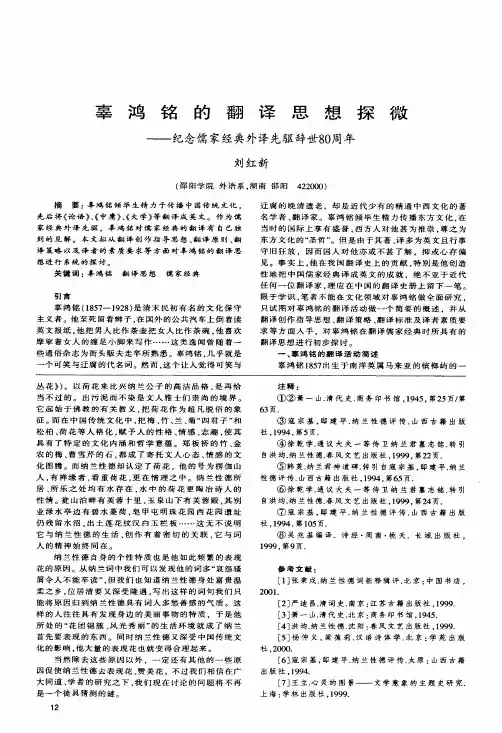
辜鸿铭的翻译照相,C一,西——纪念儒家经典外译先驱辞世80周年刘红新(邵阳学院外语系,湖南邵阳422000)摘要:辜鸿铭倾毕生精力于传播中国传统文化。
先后将《论语》、《中庸》、《大学)g-翻译成英文。
作为儒家经典外译先驱.辜鸿铭对儒家经典的翻译有自己独到的见解。
本文拟从翻译创作指导思想、翻译原则、翻译策略以及译者的素质要求等方面对辜鸿铭的翻译思想进行系统的探讨。
关键词:辜鸿铭翻译思想儒家经典引言辜鸿铭(1857—1928)是清末民初有名的文化保守主义者。
他至死留着辫子。
在国外的公共汽车上倒着读英文报纸.他把男人比作茶壶把女人比作茶碗.他喜欢摩挲着女人的缠足小脚来写作……这类逸闻曾随着一些通俗杂志为街头贩夫走卒所熟悉。
辜鸿铭,几乎就是一个可笑与迂腐的代名词。
然而,这个让人觉得可笑与探微迂腐的晚清遗老,却是近代少有的精通中西文化的著名学者、翻译家。
辜鸿铭倾毕生精力传播东方文化.在当时的国际上享有盛誉.西方人对他甚为推崇,尊之为东方文化的“圣哲”。
但是由于其著、译多为英文且行事守旧狂放,因而国人对他亦或不甚了解,抑或心存偏见。
事实上。
他在我国翻译史上的贡献,特别是他创造性地把中国儒家经典译成英文的成就,绝不亚于近代任何一位翻译家,理应在中国的翻译史册上留下一笔。
限于学识.笔者不能在文化领域对辜鸿铭做全面研究,只试图对辜鸿铭的翻译活动做一个简要的概述,并从翻译创作指导思想、翻译策略、翻译标准及译者素质要求等方面人手.对辜鸿铭在翻泽儒家经典时所具有的翻泽思想进行初步探讨。
一、辜鸿铭的翻译活动简述辜鸿铭1857出生于南洋英属马来亚的槟榔屿的一丛花》)。
以荷花来比兴纳兰公子的高洁品格,是再恰当不过的。
出污泥而不染是文人雅士们崇尚的境界。
它起始于佛教的有关教义.把荷花作为超凡脱俗的象征。
而在中国传统文化中,把梅、竹、兰、菊“四君子”和松柏、荷花等人格化,赋予人的性格、情感、志趣,使其具有了特定的文化内涵和哲学意蕴。
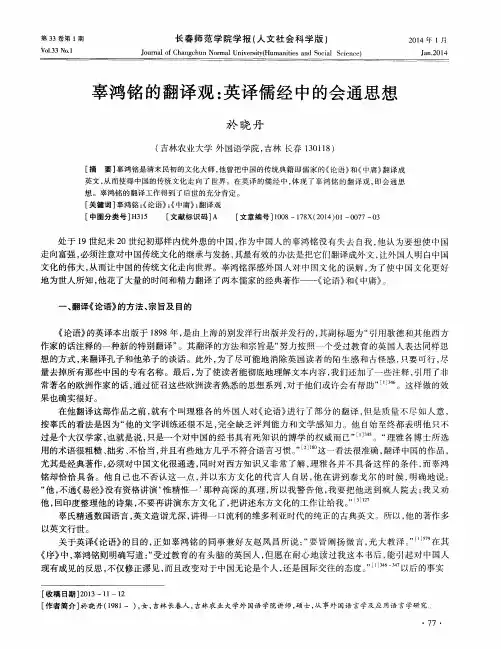
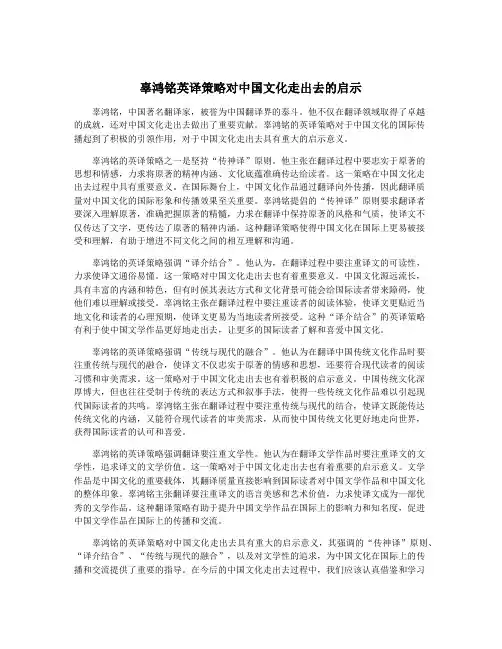
辜鸿铭英译策略对中国文化走出去的启示辜鸿铭,中国著名翻译家,被誉为中国翻译界的泰斗。
他不仅在翻译领域取得了卓越的成就,还对中国文化走出去做出了重要贡献。
辜鸿铭的英译策略对于中国文化的国际传播起到了积极的引领作用,对于中国文化走出去具有重大的启示意义。
辜鸿铭的英译策略之一是坚持“传神译”原则。
他主张在翻译过程中要忠实于原著的思想和情感,力求将原著的精神内涵、文化底蕴准确传达给读者。
这一策略在中国文化走出去过程中具有重要意义。
在国际舞台上,中国文化作品通过翻译向外传播,因此翻译质量对中国文化的国际形象和传播效果至关重要。
辜鸿铭提倡的“传神译”原则要求翻译者要深入理解原著,准确把握原著的精髓,力求在翻译中保持原著的风格和气质,使译文不仅传达了文字,更传达了原著的精神内涵。
这种翻译策略使得中国文化在国际上更易被接受和理解,有助于增进不同文化之间的相互理解和沟通。
辜鸿铭的英译策略强调“译介结合”。
他认为,在翻译过程中要注重译文的可读性,力求使译文通俗易懂。
这一策略对中国文化走出去也有着重要意义。
中国文化源远流长,具有丰富的内涵和特色,但有时候其表达方式和文化背景可能会给国际读者带来障碍,使他们难以理解或接受。
辜鸿铭主张在翻译过程中要注重读者的阅读体验,使译文更贴近当地文化和读者的心理预期,使译文更易为当地读者所接受。
这种“译介结合”的英译策略有利于使中国文学作品更好地走出去,让更多的国际读者了解和喜爱中国文化。
辜鸿铭的英译策略强调“传统与现代的融合”。
他认为在翻译中国传统文化作品时要注重传统与现代的融合,使译文不仅忠实于原著的情感和思想,还要符合现代读者的阅读习惯和审美需求。
这一策略对于中国文化走出去也有着积极的启示意义。
中国传统文化深厚博大,但也往往受制于传统的表达方式和叙事手法,使得一些传统文化作品难以引起现代国际读者的共鸣。
辜鸿铭主张在翻译过程中要注重传统与现代的结合,使译文既能传达传统文化的内涵,又能符合现代读者的审美需求,从而使中国传统文化更好地走向世界,获得国际读者的认可和喜爱。
2024年浅论辜鸿铭的文学观念引言辜鸿铭,这位在20世纪初的中国文化界颇具影响力的学者,其文学观念深深植根于中国的传统文化之中,同时又具有鲜明的时代特色。
他的文学观念不仅是对传统文学的一种继承和发展,更是对当时社会现实的深刻反思。
本文将从辜鸿铭的传统文化根基、文学与时代关系、文学翻译观、文学批评与创作、文学的社会责任等方面,对其文学观念进行深入的探讨。
传统文化根基辜鸿铭的文学观念首先扎根于中国的传统文化之中。
他深知中国古典文学的博大精深,对此有着深厚的感情和独特的理解。
他强调文学创作应该承传古人的智慧,汲取传统文化的营养。
在辜鸿铭看来,传统文化是文学的根基,只有立足于传统文化,才能创作出具有民族特色、时代精神的作品。
辜鸿铭在文学创作中,始终秉持着对传统文化的尊重和继承。
他的作品中充满了对古代文学经典的引用和诠释,展现出对中国传统文化的深刻理解和热爱。
他通过对传统文化的深入挖掘,将传统元素与现代思想相结合,形成了自己独特的文学风格。
文学与时代关系辜鸿铭认为文学与时代是密不可分的。
文学作为社会生活的反映,必须紧密关注时代的变化和发展。
他强调,文学应该站在时代的前沿,用独特的视角和深刻的洞察力去揭示社会的本质和规律。
在辜鸿铭的文学观念中,文学不仅是记录时代的工具,更是推动时代发展的重要力量。
他认为,文学作品应该积极反映社会现实,通过艺术的手段去揭示社会矛盾和问题,引导人们思考和解决这些问题。
同时,文学作品也应该具有前瞻性,能够预测和引领时代的发展方向。
文学翻译观辜鸿铭对文学翻译也有着独到的见解。
他认为,文学翻译不仅是语言的转换,更是文化的传递。
在翻译过程中,翻译者应该充分考虑到原著的文化背景和内涵,力求在译文中准确传达原著的精神和风格。
辜鸿铭强调,文学翻译应该遵循“信、达、雅”的原则。
其中,“信”指的是忠实于原著,不随意篡改或歪曲原文;“达”指的是译文要通顺流畅,易于理解;“雅”则是指译文要具有文学性,能够体现出原著的艺术魅力。
辜鸿铭的翻译除了为“国粹”狡辩之外,这位满清遗⽼的最⼤贡献,应该是翻译,因为这充分利⽤了他的专长——通晓多国语⾔,且儒经知识渊博。
以下对论语的妙译值得学习(摘⾃百度百科):翻译贡献 作为翻译家,辜鸿铭的贡献主要包括两个⽅⾯:⼀⽅⾯是将我国经典古籍《论语》、《中庸》、《⼤学》等译成英⽂,在清末民初的中书英译中最享盛誉;另⼀⽅⾯是将外国诗歌等翻译成中⽂,主要有威廉·柯伯的《痴汉骑马歌》和柯勒律治的《古⾈⼦咏》,成为近代中国向国内译介西⽅诗歌的先驱。
中国四书五经的翻译最早始于明末清初。
当时来华的外国传教⼠和汉学家把《诗经》、《易经》、《论语》、《⽼⼦》等中国古代⽂化典籍移译成多种⽂字传到欧美,有拉丁⽂、英⽂、意⼤利⽂、法⽂等译本。
要把中国古代经籍译成西⽅⽂字,就得同时精通对译的两种语⾔,能够透彻理会两国⽂化,并⾮⼀般⼈所能担任。
⽽这些传教⼠和汉学家⼤多数只是粗通汉语,因此翻译出来的作品中存在着许多不⾜之处,有的甚⾄是积字成句、积字成篇,根本⽆法从整体上体现中国⽂化的精奥之处。
到了近代,翻译孔孟著作最出名的要属理雅各(James Legge)。
理雅各是个有名的汉学家,汉语造诣很⾼。
在王韬的协助下,他把中国"⼗三经"中的⼗部经书译成英⽂,统称为《中国经典》( The Chinese Classics),在西⽅享有很⾼的声誉,到现在,仍被许多西⽅⼈视为标准译本。
但由于英汉两国语⾔、⽂化、思维⽅式等⽅⾯存在着巨⼤差异,因此理雅各的翻译虽较之以前的译著相对准确,仍不免有误解曲解、死译硬译、断章取义的现象。
辜鸿铭早在1884年发表的《中国学》⼀⽂中就指出:理雅各翻译《中国经典》的⼯作不过是应时之需,虽然数量惊⼈,但并不都令⼈满意。
辜鸿铭认为正是这些传教⼠和汉学家歪曲了儒家经典的原义,糟蹋了中国⽂化,并导致西⽅⼈对中国⼈和中国⽂明产⽣种种偏见。
为了消除这些偏见,他决定⾃⼰翻译儒家经典。
辜鸿铭《论语》翻译思想探析*———文化翻译的范例王东波摘要《论语》是中华文明的结晶和体现,自其面世以后,即开始了不断的传播历程。
在这一过程中,翻译起到了重要的媒介作用。
翻译最为主要的功能是传递信息,进行文化交流。
辜鸿铭的《论语》译本抛却了“形式对等”的桎梏,采用损益、衔接、类比等策略,充分实现了文化传播这一原始和终极的翻译目的。
关键词《论语》辜鸿铭翻译思想传播中图分类号B222.1;H159文献标识码A文章编号1002-2627(2011)02-0121-06作者:王东波,男,1964年生,山东龙口人,山东大学外国语学院教授。
济南250100儒学诞生于2500多年前的中国,它是中华民族奉献给人类的宝贵财富之一,是中国传统文化的精髓。
儒学最为重要的思想体现在《论语》中,换言之,《论语》是儒家学说的代表作,其在世界上的影响,是中国任何一部著作都无法比拟的。
因此,从明末清初开始,天主教传教士就开始了对《论语》的翻译。
在中外文化交流的历史长河中,尤其是在19世纪中后期至20世纪上半期的中西文化交流史上,对《论语》的英译和传播是一个十分值得关注的学术现象,而辜鸿铭作为华人独自全译《论语》的第一人,以其独步神州的英语造诣以及对儒家学说的精到的理解,在其译本中对中国文化进行了准确的再现,充分实现了传播儒家思想的原始目的。
一、辜鸿铭英译《论语》的心路历程在人类历史的长河中,没有一个国家或民族能够脱离外界而孤立地存在,它必定要在*本文系山东省社会科学规划重点研究项目“《论语》英译研究”(项目编号:10BWXJ09)的阶段性研究成果。
与其他国家的不断交流中生存和发展。
当不同民族精神之河的洪流奔涌到一起的时候,它们必将相互碰撞并不断汇合。
19世纪末的中国社会正是处于这样一个中西文明冲撞交汇的特殊时期,不仅有西学东渐的浪潮,也有东学西渐的暗流。
在这两股潮流的碰撞中,翻译始终发挥着它不可替代的桥梁作用:让中国人放眼世界,让西方人了解中国。
辜鸿铭英译策略对中国文化走出去的启示辜鸿铭是一位中国近代史上杰出的学者和政治家,他在中国文化走向国际舞台的推动中发挥了重要作用。
他对中国文化进行了深刻的探索和研究,并提出了许多行之有效的英译策略,为中国文化的传播和推广奠定了坚实的基础。
本文将从辜鸿铭的英译策略中探讨对中国文化走出去的启示。
一、注重语言独特性和文化背景辜鸿铭在进行英译时非常注重语言独特性和文化背景,尤其是对中国文化的特殊性做到了深入理解,他认为翻译要准确、完整、生动地传达中文原意的同时,还要注重英文的语感和表达方式,避免翻译中英文之间的文化冲突。
这种对语言独特性和文化背景的重视,对于中国文化走向国际舞台非常重要,因为只有正确理解和诠释文化内涵,才能在外国人中建立起对文化的兴趣和认同感。
二、注重文化普及和传承辜鸿铭注重将中国文化传承和普及,特别是针对中国传统文化的重要作品,如《庄子》、《红楼梦》等,他在英译过程中不但要把文化内涵传达给外国读者,还要让他们理解、接受和体验中国传统文化的瑰丽。
这种注重文化普及和传承的思想,对于中国文化走向国际舞台非常重要,因为它有助于更多的外国人了解、认同和接受中国文化,从而使中国文化更好地走向世界。
三、注重与国际接轨辜鸿铭深入研究国际翻译规范和惯例,不断与国际接轨,从而使他的英译策略更加符合国际标准。
这种注重与国际接轨的思想,对于中国文化走向国际舞台非常重要,因为只有与国际接轨,才能更好地推动中国文化在世界范围内的传播和交流。
四、注重个性表现辜鸿铭注重个性表现,在英译中不拘泥于形式规范,而是尽可能地发挥个人风格,让读者感受到翻译者的创造力和魅力。
这种注重个性表现的思想,对于中国文化走向国际舞台也非常重要,因为只有在文化传播中体现翻译者的个性魅力,才能更好地吸引外国读者,提高他们对中国文化的兴趣和认同感。
五、注重时代变革和反思辜鸿铭注重时代变革和反思,在翻译过程中,尤其是针对历史材料和文化遗产的翻译时,他注重对当代社会的反思和启示,使翻译更具有时代性和现代性。